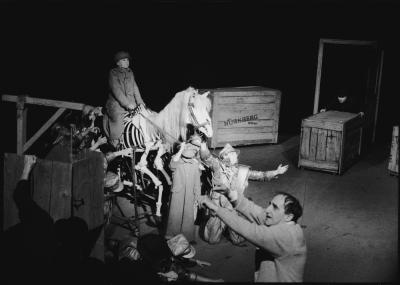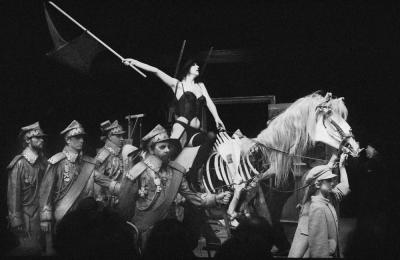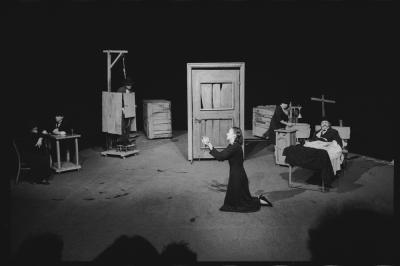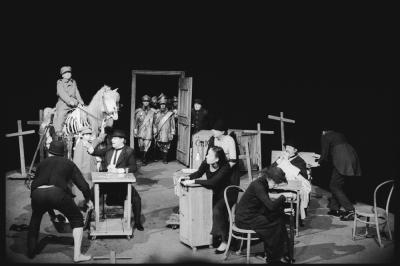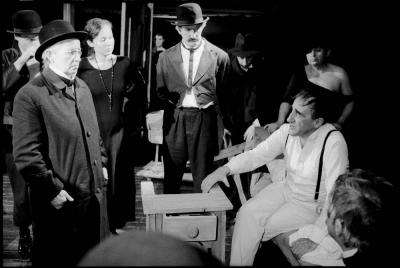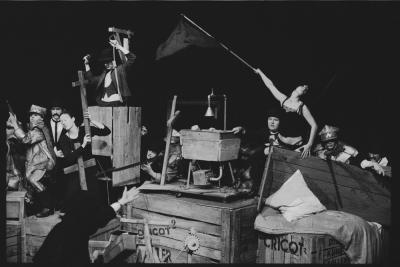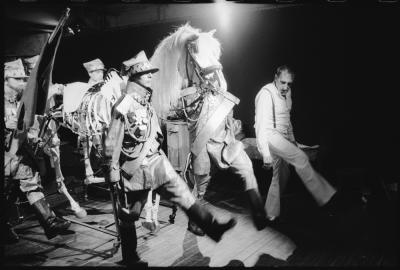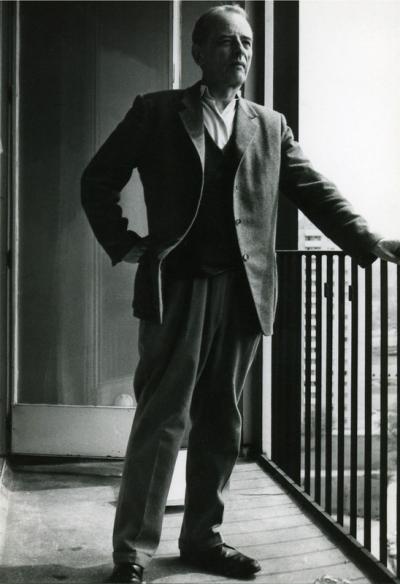Tadeusz Kantor in Nürnberg
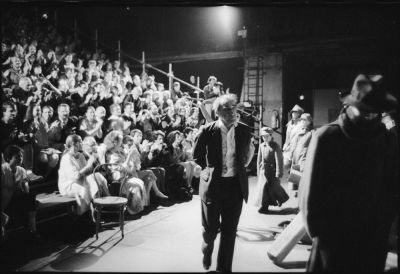
When Tadeusz Kantor climbed into the plane to travel from Warsaw to Nuremberg on 29th April 1985 he was accompanied by the members of his famous theatre “Teatr Cricot 2“ who had already made a name for themselves in the West. They were bringing their new play to Germany, a world premiere with which they would create another milestone in theatre history: “Artists should Croak” (Niech sczezną artyści).
“Teatr Cricot 2”, under the artist, painter, set designer, director and dramaturg Tadeusz Kantor, began work on “Artists should Croak“ in January 1985 in his hometown of Kraków. They were invited to Nuremberg by Dr. Karl Gerhard Schmidt, who was then the owner of the largest private bank in the Federal Republic of Germany. Schmidt, an art collector and generous patron of the arts, had found a home in the bank for the Polish Honorary Consulate in Nuremberg. Karl Gerhard Schmidt first became aware of Tadeusz Kantor in 1977 when he saw a performance of his play “The Dead Class“ (Umarła klasa) in the Alte Messehalle in Nuremberg. He was enthralled by the show and promptly turned Kantor into “his own” artist. Schmidt visited Kantor in Kraków to look at “The Dead Class“ in its place of origin, the Kszysztofory Theatre. Along with the “Institute for Modern Art“ in Nuremberg and the “Centro di Ricerce Teatrali“ in Milan Karl Gerhard Schmidt now became the personal producer of a masterpiece by the great Tadeusz Kantor.
Tadeusz Kantor was born on 6th April 1915 in Wielopole, 130 kilometres east of Kraków. At the time Wielopole was a small Polish-Jewish town in the border area of the Austrian-Hungarian monarchy. His father, who was also extremely fond of theatre, was the village teacher, and during the First World War he fought on the side of the Polish independence army. Tadeusz Kantor grew up without his father. This is the reason why his mother, Helena Berger, remained his most important personal contact until her death. He spent his school years in the village school in Wielopole and at a grammar school in Tarnów where he passed his A-levels in 1933. In the autumn of that year Kantor began a course in law at the Jagiellonen University in Kraków but this lasted a mere two weeks. He quickly switched to a private painting school run by Zbigniew Pronaszko (Wolna Szkoła Malarstwa) and in November 1934 he began a course in painting at the Academy of Fine Arts (Akademia Sztuk Pięknych) in Kraków. This is where he directed his first plays. He completed his studies at the Academy with distinction on 12th December 1939. During the Second World War he was a member of an underground artists’ theatre group and in 1942 he set up his own theatre under the name of “Teatr Niezależny” (The Independent Theatre). The first show presented by “Teatr Niezależny” was Balladyna (1943) by Juliusz Słowacki.
After the war Tadeusz Kantor initially worked as a set designer at the “Stary Teatr” (The Old Theatre) in Kraków. All this time, however, he never gave up painting. In 1946 his picture “Portret malarza” (A Portrait of the Painter) was exhibited at the first International Exhibition of Contemporary Art in the Palais Chaillot in Paris. This was followed by a huge number of individual and group exhibitions. Tadeusz Kantor then spent six months in Paris on an artists grant awarded by the Polish Ministry of Art and Culture. When he returned in 1947 he was appointed a professor at the State Art School (then the Academy of Fine Arts) in Kraków. But following anonymous libellous comments and reports from a party functionary he was expelled from the art school in 1950 and returned to work as a set designer in the “Stary Teatr” and “Teatr Słowackiego” in Kraków.
In autumn 1955 he joined forces with Maria Jerema and Kazimierz Mikulski to set up the “Teatr Cricot 2” (the name was a reference to the “Teatr Artystów Cricot” that had existed in Kraków between 1933 and 1939). This was principally a continuation of Kantor’s previous work with the “Teatr Niezależny”. Kantor produced the following shows with Cricot 2: “Mątwa” (Cuttlefish, 1956), “W małym dworku” (In the small Country House, 1961), “Wariat i zakonninca” (The Madman and the Nun, 1963) “Kurka Wodna” (The Coot, 1967), “Szewcy” (The Shoemaker, 1972) “Nadobnisie i koczkodany” (Graces and Scarecrows, 1973), “Umarła klasa” (The Dead Class, 1975), “Wielopole, Wielopole” (1980), “Niech sczezną artyści” (Artists should Croak, 1985), “Nigdy tu już nie powrócę” (I Shall Never Return Here, 1988), “Dziś są moje urodziny” (Today is my Birthday, 1991). After “Umarła klasa” at the very latest Cricot 2 had made a name for itself in the history of the theatre. There followed a series of international tours, awards and prizes. Tadeusz Kantor and his ensemble were now recognised as the re-inventors of European theatre in the period after the Second World War. He was working on stage right to the end. Tadeusz Kantor died in Kraków on 8th December 1990.
As early as 1977 the banker and arts patron Karl Gerhard Schmidt suspected that Tadeusz Kantor would become one of the most important artists of his age; and he was confirmed in his opinion in 1985 when he brought Kantor’s play “Artists should Croak” to Nuremberg. The company travelled from Kraków to Nuremberg at the end of April 1985 in order to continue their rehearsals on the play with Italian actors. The rehearsals were not easy. Kantor was moody, at times impolite, and at other times friendly. Barbara Ziegler, who was responsible for organising the stay, had a nervous breakdown. But Schmidt took her place and mastered the situation with bravura and a trick. He brought his wife to rehearsals well knowing that this “old school”gentleman would conduct himself much more quietly in her presence. As planned the premiere took place on 2nd June 1985. The play’s main themes are impermanence, dying, death and rituals after death. As in other works by Kantor there is no real plot. There are old pictures, faded photographs, fragments of memory, major historical events and insignificant lives in small back yards, all of which make up a framework and basis for a universal message.
At the centre of Kantor’s ideas there is the “room”, here a cemetery in which the almost forgotten dead rise up once again in a spiritual act. There is an ailing six-year-old boy, a group of grotesque army officers who seem to act like tin soldiers, a general riding the skeleton of a horse, and typical Kantor characters from the “lower depths” like the “card player”, the “prostitute”, the “hanging man”, the “jailer”, the dishwasher”, the “prüde” and the “dirty brat”, who continually reappear in Kantor’s art. And in the midst of all this there is Veit Stoß, one of the most famous mediaeval artists (born ca. 1447 in Horb am Neckar, died 1533 in Nuremberg), and one of Kantor’s most important artistic reference persons. Here Kantor has created a spectacular show in which the life of the great artist, death and transience are revealed in a seemingly never-ending review.
The old “Kabelmetal Casting Forge” in Nuremberg was specially adapted to meet the requirements of Teatr Cricot 2, and the show was sold out on the evening of the premiere on 2nd June 1985 and the following five performances. It proved to be an overwhelming success both for Tadeusz Kantor and for the Nuremberg theatre world (the applause lasted 15 minutes). As a result the Institute of Contemporary Art and its associated publishing house released richly illustrated books on Tadeusz Kantor, his art and his time in Nuremberg. One of these was the hitherto most comprehensive collection of Kantor’s theoretical texts, “A Traveller. His Texts and Manifestos”. Even today Karl Gerhard Schmidt can count himself lucky to be the owner of a huge number of pictures by Tadeusz Kantor. His private collection can be found in Nuremberg.
Adam Gusowski, May 2015
Additional information:
The world premiere of “Artists should Croak“ in Nuremberg was not Kantor’s first stay in Germany. As early as 1959 he had exhibited his pictures in the Düsseldorf “Kunsthalle” and at the Documenta 2 in Kassel. In 1964 his pictures were featured at the Profile IV in Bochum. He stayed for a somewhat longer time in Baden-Baden in 1966, where he directed the play “The Cupboard” with German actors. He subsequently travelled with the play to Munich, Heidelberg, Bochum and Essen. In 1977 he had a solo exhibition in the Galerie Ricard in Nuremberg. In the same year he took part in the Documenta 6 in Kassel. Equally in 1977 he showed his “Dead Class” in Nuremberg (Alte Messehalle) and Erlangen (Theater in der Garage). In 1981 the Nuremberg Playhouse showed “Wielopole, Wielopole”. In 1986 Cricot 2 also presented the play along with “Artists should Croak” in der Theatermanufaktur in West Berlin. In the same year Tadeusz Kantor also had a solo exhibition in the Galerie Eva Poll in West Berlin. He showed his “Maszyna miłości i śmierci” (Machine of Love and Death) in 1987 as part of the “Spiel Räume” project at Documenta 8 in the State Theatre in Kassel. In 1988 Cricot 2 presented their show “Nigdy tu już nie powrócę” (I Shall Never Return Here) in the Academy of Arts in West Berlin. Two years later the Eva Poll Gallery presented an exhibition of Kantor’s drawings. His last play, directed after his death by actors from Teatr Cricot 2, was “Dzis są moje urodziny“ (Today is my Birthday). It was shown on several occasions in Germany, including at the Hebbel Theater in Berlin.
Important awards (a selection)
1976 - The special prize for “Umarła klasa” (The Dead Class) at the 17th Festival of Polish Contemporary Art in Wrocław (Breslau)
1976 - The Boy Prize for “Umarła klasa” (The Dead Class)
1977 - The Norwid critics prize for “Umarła klasa” (The Dead Class)
1978 - The first prize in Caracas for “Umarła klasa” (The Dead Class)
1978 - The Rembrandt Prize awarded by an international jury of the Goethe Foundation in Basilea for a real contribution to shaping art in our era
1980 - An OBIE awarded by the New York theatre critics in 1979 for “Umarła klasa” (The Dead Class)
1981 - A prize awarded by the Minister of Art and Culture (First Grade) for his theatre set designs
1982 - A diploma from the Foreign Minister of the People’s Republic of Poland for spreading Polish culture abroad
1986 - The "Targa Europea" Prize for significant representatives of culture and education (Italy)
1986 - The New York critics prize for the best Broadway performance (director and actor) for "Niech sczezną artyści" (Artists should Croak)
1989 - The Ordre des Arts et des Lettres (Order of Arts and Letters), France
1990 - The major Cross of Merit awarded by the Federal Republic of Germany for his significant influence on contemporary art in Europe and for services to reviving culture in the Federal Republic of Germany
